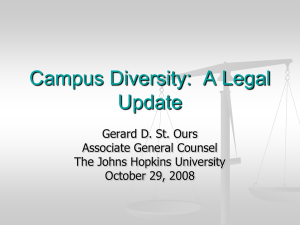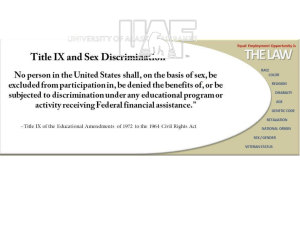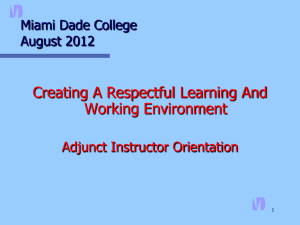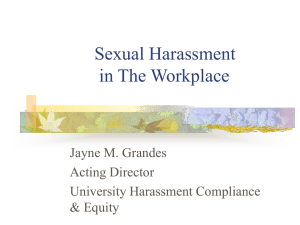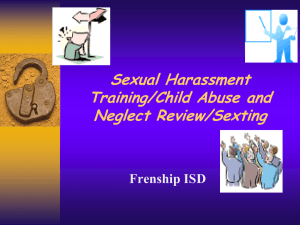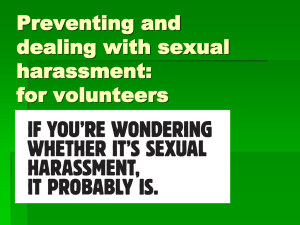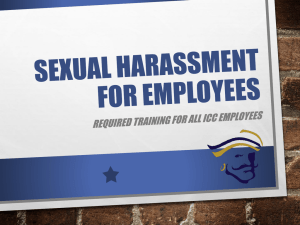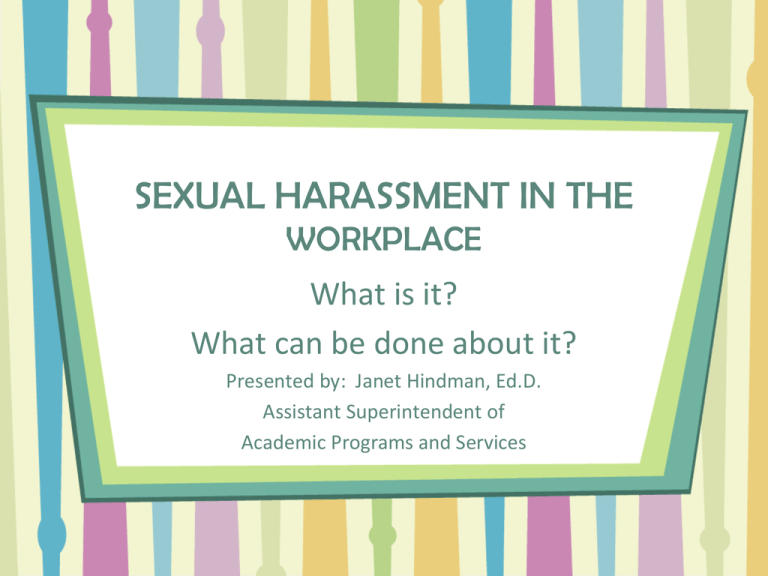
SEXUAL HARASSMENT IN THE
WORKPLACE
What is it?
What can be done about it?
Presented by: Janet Hindman, Ed.D.
Assistant Superintendent of
Academic Programs and Services
Today’s Objectives for All Employees
• Identify sexual
harassment when given
real-life scenarios.
• Describe the federal laws
prohibiting sexual
harassment and the
penalties attached to their
violation.
Today’s Objectives for All Employees
• Explain the complaint process and list
the steps in the reporting procedure.
• Identify specific corrective actions that
will help remedy sexual harassment
situations in the classroom and
on the job.
Why Do We Need To Be Concerned
About Sexual Harassment?
1992 Supreme Court Case of
Franklin vs. Gwinnett
Why Do We Need To Be Concerned About
Sexual Harassment?
• Educational institutions may be
forced to pay damages to victims
of sexual harassment.
• Violates an individual’s legal right.
• Produces a negative impact on all
students and employees within the
institution.
The Costs of Sexual Harassment
• Sexual harassment claims filed with the
Equal Employment Opportunity
Commission (EEOC) and the Office of Civil
Rights (OCR) continue to climb at a steady
rate of 12 to 13 percent each year.
The Costs of Sexual Harassment
• Sexual harassment charges
are now the FOURTH most
frequently alleged
discrimination issue brought
before the EEOC.
• Yet, they are
Negative Effects of Sexual Harassment
• Lower productivity of
employees and
diminished learning on
the part of students;
• Higher costs due to
lower efficiency;
Negative Effects of Sexual Harassment
• Increased absenteeism, turnover, and drop
out rates;
• Court awards, settlements, and fees;
• Damage to the institution’s public image;
and
• Deterioration of student and staff morale
and organizational climate.
Definition of Sexual Harassment
• Sexual harassment is unwanted sexual or
gender-based behavior that occurs when
one person has formal or informal power
over another.
Elements of Sexual Harassment
•
•
•
•
Unwelcome sexual advances;
Requests for sexual favors;
Other sexual conduct--physical or verbal;
Any conduct or offensive unequal
treatment which occurs because of gender.
Types of Sexual Harassment
• Quid Pro Quo –
“This for that.”
• Hostile
Environment
Quid Pro Quo
• “This for that.”
• Supervisor commits quid pro
quo harassment if (s)he
makes decisions based on
whether an employee
accepts or refuses sexual
advances.
Quid Pro Quo
• Submission to the
• Submission to or
conduct is made a
rejection of the
term or condition,
conduct is used as a
either explicitly or
factor in decisions
implicitly, of
affecting that
obtaining education
person’s education
or employment.
or employment.
Hostile Environment
• Co-workers create a hostile environment if
they interfere with another employee’s
work by doing or saying sexually offensive
things.
Hostile Environment Harassment
• The victim is usually subjected to
unwelcome repeated sexual
comments, innuendoes, or touching, which
alter conditions or interfere with school or
employment performance or access to
opportunities provided by the institution.
Hostile Environment Harassment
• Conduct is gender-based and creates an
intimidating or offensive place for
employees to work or students to go to
school.
• This usually requires a pattern of this sort of
behavior, but sometimes one incident is
enough, if severe or outrageous.
Hostile Environment Harassment
• Can occur off campus grounds, e.g., school
sporting events, on a school bus, on a
school trip, in a college sponsored
internship program;
• Can be caused by teachers, professors,
administrators, bus drivers, or other staff,
students, vendors, or persons temporarily
on campus.
KEY WORD = UNWELCOME
• Unwanted, unsolicited behavior
• Imposed on another
What Constitutes Sexual Harassment?
• PERCEPTION
• NOT INTENT
• U.S. Supreme Court
determined the
conduct is sexual
harassment if a
reasonable person
with the victim’s
perspective
considers it so.
Examples of Sexual Harassment
• Sexual innuendoes
and comments
• Intrusive sexually
explicit questions
• A neck/shoulder
massage
• Rating a person’s
sexuality
• Repeatedly asking a
person out for
dates or to have sex
• Sexual ridicule
• Frequent jokes
about sex or
males/females
Examples of Sexual Harassment
• Touching, patting,
pinching, stroking,
squeezing, tickling,
or brushing against
someone.
• Stalking a person;
• Attempted or
actual sexual
assault;
• Letters, notes,
telephone calls of a
sexual nature.
Employee Responsibility to Report Sexual
Harassment
• Be professional and business-like.
• Be direct and candid about the behavior
and your feelings.
• Report the incident to your supervisor or
the District Title IX coordinator.
• Document actions for your reference.
Title IX Coordinator
Janet Hindman
Assistant Superintendent of Academic
Programs and Services
Box 30430
Amarillo, Texas 79120 / 806-335-2823
Ext. 217
Employee to Student Sexual Harassment
• Title IX Office of Civil Rights (OCR) defines:
Sexual Harassment as
__________________.
• Quid Pro Quo
• Hostile Environment
• Legitimate Non-Sexual Touching
Employee to Student
Sexual Harassment
• Quid Pro Quo – School employee explicitly or
implicitly makes an educational decision based on
a student’s submission to unwelcome sexual
advances.
• Hostile Environment – sexually harassing conduct
by an employee, another student, or third party,
that is so severe, persistent, or pervasive that it
limits a student’s ability to benefit from an
educational program.
“Legitimate Non-Sexual Touching”
Guidelines state that harassment
does not include “legitimate nonsexual touching” such as hugging a
student who has achieved a goal or
consoling a child with an injury.
Was the Conduct Welcome?
• Romantic relationships between District
employees and students constitute
unprofessional conduct and are prohibited
as outlined in the Employee Handbook.
• OCR will NEVER view sexual conduct
between an adult school employee and an
elementary school student as consensual.
Was the Conduct Welcome?
• OCR RARELY considers a romantic
relationship consensual between an
employee and a secondary student.
• HPISD and our community would
NEVER view this behavior as appropriate.
Was the Conduct Severe,
Persistent, or Pervasive?
OCR considers several factors:
• Degree to which the conduct affected one
or more students’ education or adults’
performance;
• The type, frequency, and duration of the
conduct;
• Number of individuals involved;
Was the Conduct Severe,
Persistent, or Pervasive?
• Age and sex of the alleged harasser and the
subject of harassment;
• Size and location of the school and context
in which incident occurred;
• Other incidents at the school;
• The identity and relationship of the
individuals involved.
Student to Student Sexual Harassment
– Can We Be Held Liable?
Davis vs. Monroe County Court Case
reveals that school districts may be
held liable for money damages in a
case of student to student sexual
harassment under Title IX.
Davis vs. Monroe County
U.S. Supreme Court held that school districts
can be held liable in damages only where
the school district is deliberately indifferent
to sexual harassment, of which the school
district has actual knowledge, and deprives
victims of access to educational
opportunities.
Can We Be Held Liable?
• School districts may be liable in damages under
Title IX only for the school district’s failure to act
immediately and decisively to end the
harassment.
• The court established a duty upon the school
districts to attempt to not permit student to
student peer sexual harassment in school, during
school hours, on school grounds, or at schoolsponsored activities.
Can We Be Held Liable?
• Caution is best when it comes to sexual
harassment.
• When in doubt as to whether they have
witnessed casual teasing or sexual
harassment, school employees must report
what they have seen -- it is not up to the
employee to make judgment calls.
Examples of Student to Student
Sexual Harassment
• Mooning;
• Streaking;
• Shouting
obscenities;
• Leaving obscene
messages on
computers;
• Bra, pants, shorts,
or skirt snapping;
• Pulling down
someone’s pants,
shorts, or skirt;
• Flipping up skirts;
Examples of Student to Student
Sexual Harassment
• Telling someone
• Teasing females or
what sexual
males about their
behaviors the
sexuality, breasts,
speaker would like to or genitals;
engage in with that • Touching and
person;
grabbing.
• Whistling or yelling
at women who walk
by or rating them.
What Everyone Should Know!
•
•
•
•
•
•
•
Take the report seriously.
Listen, sympathize, but don’t judge.
Don’t delay.
Respond to concern.
Document: DATE and TIME
Follow-up on the complaint
Avoid using Dangerous Words.
DANGEROUS WORDS
• WHEN RESPONDING TO COMPLAINTS, BE
CAREFUL THAT THESE WORDS DO NOT
COME OUT OF YOUR MOUTH:
• It’s just teasing – no big deal.
• It’s just a joke – lighten up.
• The people in our school would never do . . .
• I know (s)he didn’t mean anything like that.
DANGEROUS WORDS
• “It’s your fault for
dressing so
provocatively.”
• “You need to learn to
handle these things.”
• “Just ignore it.”
• “He puts his arm
around everyone.”
• “You must have
wanted it or you
would have told him
no.”
• “That’s how they do
things where he
comes from.”
DANGEROUS WORDS
• “This kind of behavior
is part of growing up.”
• “Why can’t you learn
to accept a
compliment?”
• “It’s a matter of
hormones, we can’t
control that.”
• “If we had to discipline
every student who
used bad language,
we’d never get
anything else done.”
Five Steps When Encountering
Sexual Harassment
1.
2.
3.
4.
Take steps to remedy the immediate situation.
Speak to the offending student after class.
Speak to the student who was offended.
If you think the behavior could be sexual
harassment, report it to an administrator.
5. If you deem it necessary or the student requests
it, separate the students.
Employee Responsibility
• If behavior does not • Information about
cease, file a formal
sexual harassment
complaint or
or sexual abuse of a
grievance.
student shall be
reported to the
appropriate
authorities as
required by law.
Misconceptions
• Sexual harassment concerns are killing humor.
• Humor in the classroom isn’t dead. But jokes or
kidding can become bad news when . . .
- There’s a power difference by position
- There’s a numerical or other power imbalance
between you and your group and another
person involved.
Misconceptions
- When the jokes are frequent and sexually
explicit or graphic.
- When the jokes are unwelcome.
• Sexual harassment concerns are killing freedom of
speech.
• Freedom of speech involves the free discussion of
ideas . . . It does not include asking students or
employees for sexual favors or intimidating them
because of gender.
REMEMBER
• To be sexual harassment the following must
be considered:
• The frequency and severity of the conduct.
• Was the conduct unwelcome?
• Was it sexual?
• Was it gender-based?
Personal Behavior Checklist
Maintaining harassment-free schools and
campuses is critical for encouraging:
• An open learning environment;
• Productive and happy employees;
• Good relationships between students
and employees of both genders.
Use the checklist to examine
how you behave:
• Does this behavior
contribute to getting
our goals
accomplished?
• Could this behavior
hurt my fellow
employees or other
students if they were
here?
• Could this behavior be
interpreted as harmful
or harassing by an
outsider?
• Could this behavior be
sending out signals
that invite harassing
behavior on the part
of others?
A Rule of Thumb When Considering How
an Action will be Perceived:
WHEN IN DOUBT, DON’T!
SUMMARY: What is Sexual Harassment?
It is sometimes difficult to define sexual harassment
for three reasons:
1. What is inappropriate for one person may be
acceptable to another.
2. There is no single test for distinguishing sexual
harassment from merely offensive or
inappropriate conduct, although there are
guidelines.
3. Context is important.
SUMMARY: What is Sexual Harassment?
So, when does:
• A look become a leer?
• A touch become a grope?
• A joke become a taunt?
• A tease become harassment?
WHEN THE BEHAVIOR IS UNWELCOME
BY THE PERSON FOR WHICH
IT WAS INTENDED.
Thank you!
• If you have any questions or need any help,
please call!

